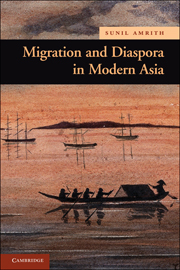Book contents
- Frontmatter
- Contents
- List of Plates, Tables, and Maps
- Acknowledgements
- Select Timeline
- Glossary
- Maps
- Introduction
- 1 Asia's Great Migrations, 1850–1930
- 2 The Making of Asian Diasporas, 1850–1930
- 3 War, Revolution, and Refugees, 1930–1950
- 4 Migration, Development, and the Asian City, 1950–1970
- 5 Asian Migrants in the Age of Globalization, 1970–2010
- Conclusion
- Guide to Further Reading
- Index
1 - Asia's Great Migrations, 1850–1930
Published online by Cambridge University Press: 05 June 2012
- Frontmatter
- Contents
- List of Plates, Tables, and Maps
- Acknowledgements
- Select Timeline
- Glossary
- Maps
- Introduction
- 1 Asia's Great Migrations, 1850–1930
- 2 The Making of Asian Diasporas, 1850–1930
- 3 War, Revolution, and Refugees, 1930–1950
- 4 Migration, Development, and the Asian City, 1950–1970
- 5 Asian Migrants in the Age of Globalization, 1970–2010
- Conclusion
- Guide to Further Reading
- Index
Summary
Between 1850 and 1930, migration in Asia reached massive and unprecedented proportions. This expansion of migration took place amid widespread political and economic transformations. In these decades, most of Asia came under the domination, if not the direct control, of European empires. Asian peasant producers were more closely integrated – or subordinated – to world markets. Human migration and intensified production brought about fundamental ecological change. Many parts of Asia remained frontiers in the mid-nineteenth century: they were lightly populated, inhabited by shifting cultivators, and covered by jungle. Less than a century later, there were few Asian frontiers left.
At the same time, historical change in Asia became ever more closely connected with change on a global scale. From the middle of the nineteenth century, C.A. Bayly wrote, ‘contemporary changes were so rapid and interacted with each other so profoundly, that this period could reasonably be described as the “birth of the modern world”’. Imperial states grew in power and capacity, and made greater demands on their subjects; ideas travelled around the world more rapidly and spread more widely than ever before; industrialization began to connect markets around the world more closely together. There was a ‘step change in human social organization’.
- Type
- Chapter
- Information
- Migration and Diaspora in Modern Asia , pp. 18 - 56Publisher: Cambridge University PressPrint publication year: 2011
- 2
- Cited by



